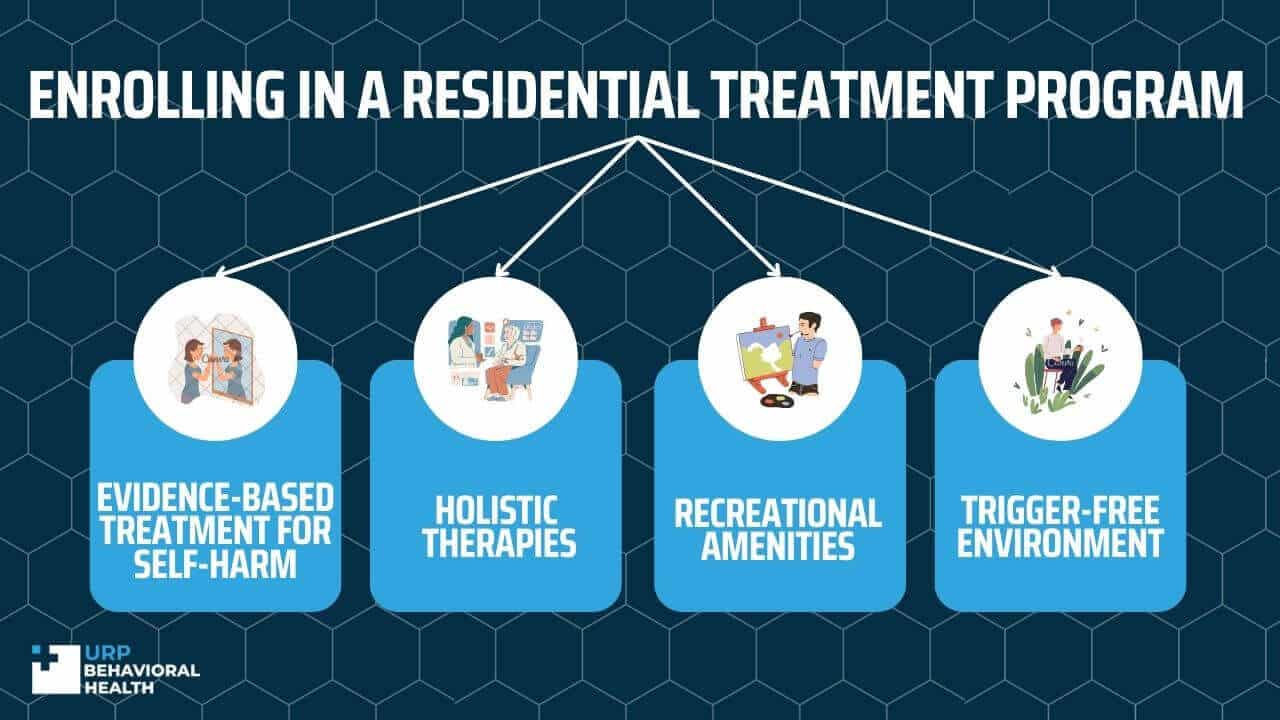
How To Stop Self-Harm Behaviors
When you’re struggling with overwhelming emotional distress, you may feel like the only way to cope with it is by engaging in self-harm behavior. Though it can provide you with momentary relief by taking your attention away from your overwhelming thoughts, it’s not a permanent solution. According to one analysis of the prevalence of non-suicidal self-injury, about 17 percent of people will engage in some form of self-harm. But many people don’t seek help from professionals and talk to friends instead.
Because self-harm behaviors are prevalent, it’s important to know how you should prevent a loved one from engaging in self-harm. Let’s discuss the types and signs of self-harm, how you can get help, and techniques to stop.
What is Self-Harm?

Self-harm involves hurting yourself as a coping mechanism to deal with overwhelming experiences, painful memories, and difficult feelings. According to the American Psychological Association, non-suicidal self-injury, commonly referred to as NSSI, is characterized by deliberately self-inflicting harm without intending to commit suicide.
When you engage in self-harm, you may cut your skin or carve words in your skin, burn yourself, punch objects, or embed objects in your skin.
In fact, it includes performing any other behavior that’s intended to cause pain but not suicide. Most commonly, people choose to self-harm in areas such as the wrists, thighs, hands, arms, and stomach, but they may self-harm in other areas as well.
Signs That Someone Engages in Self-Harm Behaviors
If you suspect that a friend or family member is self-harming, you should look out for the following signs. At URP Behavioral Health, mental health experts look for signs of self-harm when conducting an evaluation.
They may look for unexplained wounds like cuts, bruises, or scars on the body. People who engage in self-harm, like cutting, may stay fully covered, even in hotter weather, to avoid showing their scars. Their eating habits may show some changes, like restricted eating or overeating, and this may result in weight loss or gain.
People who self-harm also show signs of depression, such as social withdrawal and a lack of interest in activities that they used to enjoy. If you notice these signs and are concerned about a loved one potentially self-harming, you should help them seek professional help.
Our team will verify your insurance and design a plan tailored to your needs.
Types of Self-Harm
Most people associate self-harm with cutting, but this can lead other types of self-harm behavior to go unnoticed. Besides cutting, other types of self-harm include:
- Burning your skin using a lighter, matches, cigarettes, or candles.
- Using ligatures like a rope to strangle yourself and other asphyxiation techniques such as the ‘choking game.’
- Hitting yourself by slapping, punching, scratching, or biting
- Pulling out your hair or banging your head against the wall
- Poisoning yourself with unidentified chemicals or medication
- Engaging in risky behavior like unsafe sex or reckless driving
- Picking at scabs and open wounds to prevent them from healing
In addition to these behaviors that cause feelings of physical pain, people may engage in substance abuse or get into fights with others. The APA explains that males are more likely to have others hurt them, and it’s growing increasingly common for people to exercise until they collapse.
How To Get Help and Stop Self-Harm

Once you recognize that you have a problem of self-harm and struggle to cope with it, the most effective way of stopping the cycle is to seek professional help. There are different ways to do this, with the most important being that you visit a mental health treatment center.
Unfortunately, many people who self-harm struggle with seeking help. If you’re having trouble going to a mental health professional, you can do the following:
Call a Crisis Helpline
A crisis helpline has trained volunteers and crisis counselors who can provide you with confidential support. Here, you’ll remain anonymous, and you get the opportunity to talk about whatever’s troubling you. They can also address your concerns surrounding seeking professional help while ensuring that you’re not at risk of any immediate danger.
See Your Doctor
If you’re physically injuring yourself using sharp objects or other methods, it’s important to see a general physician. Your physician will inform you how to take care of minor cuts, burns, and other injuries. Doctors are trained to spot signs of self-harm and can take careful measures to refer you to a psychiatrist for an assessment.
Talk To Someone
Self-harm statistics show that only about half of people who engage in self-harm behavior actually end up seeking help. Usually, their loved ones need to take the first step in assisting them and ensuring that they get the help they need.
That’s why it’s best to talk to a close friend or family member about what you’re going through. If the thought of seeking professional help on your own is too overwhelming, having someone familiar with you can make you more receptive.
Techniques to Stop Self-Harm

Seeking psychological treatment and undergoing evidence-based treatments are highly effective methods of stopping the self-harm cycle. But if you’re experiencing painful emotions, overwhelming thoughts, or traumatic memories right now, it can push you to self-harm as a way to cope with the distress.
In these situations, you need techniques to stop self-harm and manage your emotions.
Change Your Environment
One of the first things that professionals recommend is to change your environment. So, if you’re indoors or at home, you should go outside. Changing your environment diverts your attention from overwhelming feelings and takes you far away from tools you may potentially use to self-harm.
It allows you to spend enough time away from those tools so that you no longer feel the urge once you’re back home. Talking a walk or engaging in light exercise can do you some good, as studies report that it can suppress the urge to self-harm. The study also mentions that being around other people can be helpful as well.
Delay Self-Harm
If getting up and leaving the house seems difficult, you should try delaying self-harm by telling yourself to wait five minutes. It’s possible that the urge will pass once the five minutes are up. The next time you feel the urge to self-harm, increase the amount of time that you wait. Gradually, you’ll increase intervals between episodes of self-harm.
Don’t wait - confidential help is available right now for you or your loved one.
Express Your Feelings
Another technique to distract yourself and stop self-harm behavior is to try expressing your feelings. You can do this by painting, drawing, or simply writing down how you feel. When your emotions are too painful to handle, labeling them can help you process them easily. By writing a journal, you learn to articulate complex feelings and pinpoint specific triggers that drive you to self-harm.
Harm Minimization
There are many reasons why people self-harm, and if you feel like you must, harm minimization techniques can help. These are short-term strategies designed to mimic the sensation of self-harming behavior without the risks of infection or long-term damage. It includes snapping a rubber band on your wrist, pinching yourself, or holding ice in your hand.
These tactics are useful when you’re not completely ready to stop self-harming but want to stay safe while you’re practicing other ways to cope with your feelings.
Enrolling In a Residential Treatment Program

If you or a loved one has developed a pattern of recurring self-harm and requires constant monitoring, an inpatient treatment program can help. United Behavioral Health is a residential treatment facility designed to address major behavioral concerns. This includes non-suicidal self-injury, which can interfere with your ability to live a fulfilled and productive life.
For people who are consistently at risk of self-harm behavior. A residential treatment program offers four essential components:
Evidence-Based Treatment for Self-Harm
An inpatient treatment program will offer evidence-based treatments for self-harm, such as:
- Cognitive behavioral therapy (CBT) can help you identify negative thought patterns and change them. By alleviating anxious symptoms, it reduces the likelihood of self-harming behavior.
- Psychodynamic therapy will involve exploring your unconscious conflicts, which may be causing you to behave aggressively towards yourself. Once you’re conscious of these thoughts, your therapist will help you manage them.
Holistic Therapies
Residential treatment centers like URP Behavioral Health take a holistic approach toward treatment, so they combine holistic therapies with evidence-based interventions. You can expect to learn strategies like breathwork, yoga, mindfulness meditation, and therapeutic massage. These techniques train you to manage stress levels during overwhelming situations.
Recreational Amenities
For people who self-harm, it seems like the only way to cope with how they feel. During residential treatment, you’ll be away from sharp items, lighters, and other tools used for self-harm. This will allow you to explore recreational activities like exercise and being outdoors as a way to cope with your emotions.
Trigger-Free Environment
Because residential treatment requires you to stay at the facility, you’ll remain in a comfortable environment that’s free of any triggers that can push you to self-harm.
Contact our admissions team now to begin your path toward a brighter future.
Conclusion
Self-harm is a way for many people to cope with uncomfortable emotions, but there are better methods. While some methods of self-harm are obvious, like cutting or burning, others are less so, like substance abuse and reckless behavior. If you experience the urge to self-harm, try distracting yourself or writing down how you feel. There are many ways to get help if you can’t visit a mental health treatment center, such as calling a crisis helpline or seeing a general physician. But if you need constant monitoring, enrolling yourself in a residential treatment program is the best approach.
















